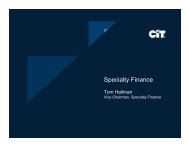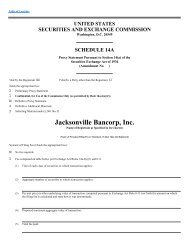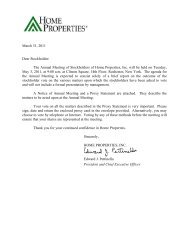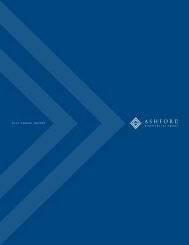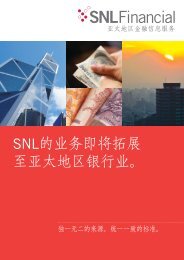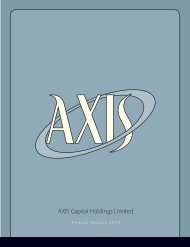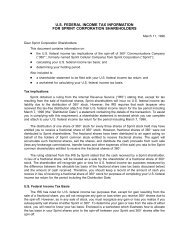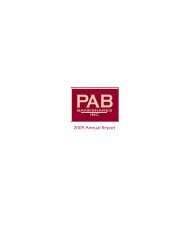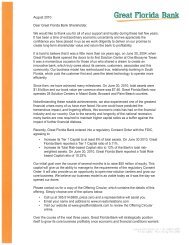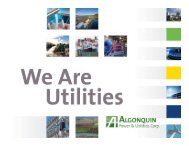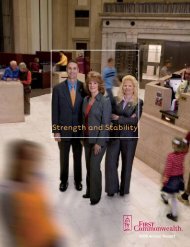Cousins Properties Incorporated 2006 Annual Report - SNL Financial
Cousins Properties Incorporated 2006 Annual Report - SNL Financial
Cousins Properties Incorporated 2006 Annual Report - SNL Financial
You also want an ePaper? Increase the reach of your titles
YUMPU automatically turns print PDFs into web optimized ePapers that Google loves.
COUSINS PROPERTIES INCORPORATED AND SUBSIDIARIES<br />
NOTES TO CONSOLIDATED FINANCIAL STATEMENTS — (Continued)<br />
of payroll-related benefits to each project under construction based on time spent on each such project. Interest is<br />
capitalized to qualifying assets under development in accordance with SFAS No. 34, “Capitalization of Interest<br />
Costs,” and SFAS No. 58, “Capitalization of Interest Cost in <strong>Financial</strong> Statements That Include Investments<br />
Accounted for by the Equity Method.” The Company capitalizes interest on average accumulated expenditures<br />
outstanding during a period on qualifying projects based first on interest incurred on specific project debt, if any,<br />
and next using the weighted average interest rate for non-project specific debt. The amount of interest capitalized<br />
does not exceed the actual interest incurred by the Company during any period presented. Interest is also capitalized<br />
to investments accounted for under the equity method when the investee has property under development with a<br />
carrying value in excess of the investee’s borrowings. To the extent that there is debt at the venture during the<br />
construction period, the venture capitalizes interest using the specifics of that debt.<br />
Interest, real estate taxes and operating expenses of properties are also capitalized based on the percentage of<br />
the project available for occupancy from the date a project receives its certificate of occupancy, to the earlier of the<br />
date on which the project achieves 95% economic occupancy or one year thereafter.<br />
Leasing costs capitalized include commissions paid to outside brokers and outside legal costs to negotiate and<br />
document a lease agreement. These costs are capitalized as a cost of the tenant’s lease and amortized over the related<br />
lease term. Internal leasing costs are capitalized utilizing guidance in SFAS No. 91, “Accounting for Nonrefundable<br />
Fees and Costs Associated with Originating or Acquiring Loans and Initial Direct Costs of Leases.” Leasing<br />
personnel are queried monthly, and the Company capitalizes their compensation and payroll-related fringe benefits<br />
directly related to time spent performing initial direct leasing activities.<br />
Impairment: Long-lived assets include property, goodwill and other assets which are held and used by an<br />
entity. The Company evaluates the carrying value of its long-lived assets in accordance with SFAS No. 144,<br />
“Accounting for the Impairment or Disposal of Long-Lived Assets,” and SFAS No. 142, “Goodwill and Other<br />
Intangible Assets.” Management reviews the carrying value of long-lived assets for the existence of any<br />
other-than-temporary indicators of impairment. For long-lived assets other than goodwill, the Company recognizes<br />
impairment losses, if any, on held for use assets when the fair value, calculated as the expected undiscounted future<br />
operating cash flows derived from such assets, are less than their carrying value. In such cases, the carrying value of<br />
the long-lived asset is reduced to its fair value. Additionally, the Company recognizes impairment losses if the fair<br />
value of a property held for sale, as defined in SFAS No. 144, net of selling costs, is less than its carrying value. The<br />
Company ceases depreciation of a property when it is categorized as held for sale. The Company has recorded no<br />
such impairment losses within its consolidated entities during <strong>2006</strong>, 2005 or 2004. The accounting for long-lived<br />
assets is the same at the Company’s unconsolidated joint ventures, one of which recorded an impairment loss in<br />
2004 on a held for sale property (see Note 6 — CP Venture LLC and CP Venture Two LLC). No impairment losses<br />
were recorded by the Company’s unconsolidated joint ventures in 2005 or <strong>2006</strong>.<br />
The Company evaluates the carrying value of its investments in unconsolidated joint ventures in accordance<br />
with Accounting Principles Board (“APB”) Opinion No. 18, “The Equity Method of Accounting for Investments in<br />
Common Stock.” The Company utilizes a discounted cash flow analysis and evaluates the results of that calculation<br />
to determine if an other-than-temporary impairment exists. The Company concluded that it did not have an<br />
impairment in any of its investments in joint ventures in <strong>2006</strong>, 2005 or 2004.<br />
The Company evaluates the carrying value of its goodwill in accordance with SFAS No. 142. The Company<br />
records no amortization of goodwill, but it is tested annually, at the same time each year (or at any point during the<br />
year if indicators of impairment exists), for impairment using a discounted cash flow analysis. For all periods<br />
presented, the tests for impairment of goodwill did not result in any impairment. The goodwill relates entirely to the<br />
office reporting unit. As office assets are sold, either by the Company or at its joint ventures, goodwill is allocated to<br />
the cost of each sale.<br />
Acquisition of Operating <strong>Properties</strong>: The Company allocates the purchase price of operating properties<br />
acquired to land, building, tenant improvements and identifiable intangible assets and liabilities based upon relative<br />
F-8




